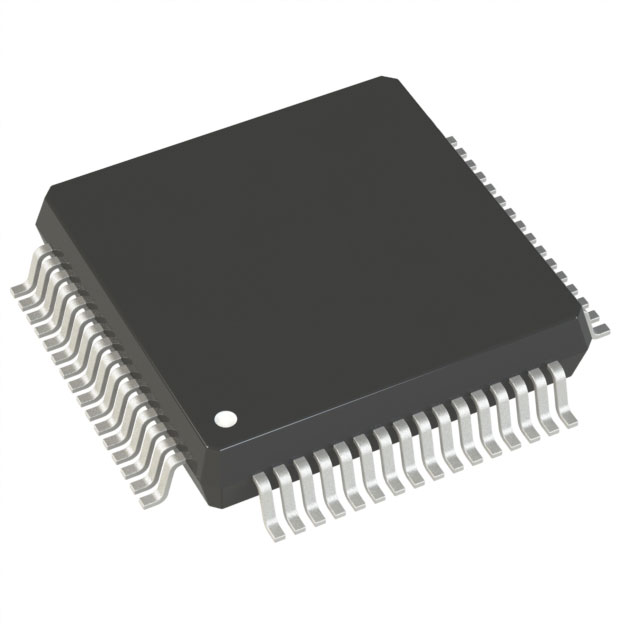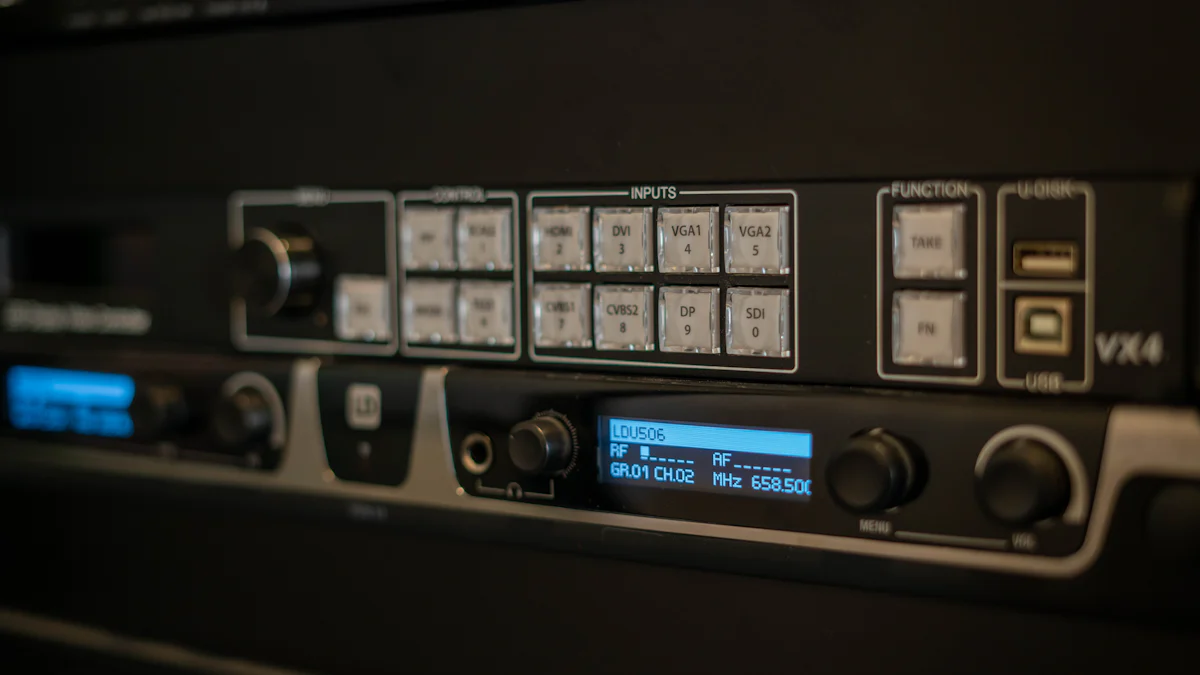AD7656BSTZ: Discover ADI's 16-Bit ADC Magic

Analog-to-Digital Converters (ADCs) are essential components in contemporary electronic systems, converting analog signals into digital data for precise measurement and control. The AD7656BSTZ, a 16-Bit Analog-to-Digital Converter (ADC) from ADI, exemplifies the remarkable capabilities of this technology. This high-resolution ADC is vital for applications that require exceptional accuracy. The importance of such devices is highlighted by the anticipated growth of the ADC market, projected to reach US$ 27.37 billion by 2033. These advancements underscore the increasing dependence on ADCs across various industries. For more information on this transformative technology, visit https://www.alldatasheet.com/datasheet-pdf/view/13.
Key Features of the AD7656BSTZ

16-Bit Resolution
The AD7656BSTZ, a 16-Bit Analog-to-Digital Converter (ADC) from ADI, stands out due to its high-resolution capabilities. High resolution in ADCs is crucial for precise data conversion. A 16-bit resolution provides 65,536 distinct levels, ensuring detailed and accurate signal representation. This level of precision is essential in applications where even minor signal variations must be captured accurately.
In comparison, lower resolutions like 8-bit offer only 256 distinct levels, which may suffice for less demanding applications but fall short in high-precision environments. The 16-bit resolution of the AD7656BSTZ, therefore, offers superior Signal-to-Quantization Noise Ratio (SQNR), making it ideal for applications requiring exceptional accuracy. Although it may come at a higher cost compared to 10-bit ADCs, the benefits in terms of data fidelity and performance justify the investment.
Six Channels
The AD7656BSTZ features six channels, enhancing its versatility and efficiency in multi-signal environments. Multiple channels allow simultaneous data acquisition from different sources, streamlining processes and reducing the need for additional ADCs. This capability is particularly beneficial in complex systems where multiple signals must be monitored and processed concurrently.
Use cases for multi-channel ADCs like the AD7656BSTZ include industrial automation, medical imaging, and telecommunications. In these fields, the ability to handle multiple inputs efficiently can significantly improve system performance and reliability. The AD7656BSTZ's multi-channel design ensures that it meets the demands of diverse applications, providing flexibility and scalability.
250 kSPS Sampling Rate
The AD7656BSTZ operates at a sampling rate of 250 kSPS (kilo-samples per second), which is a critical factor in determining the ADC's performance. The sampling rate refers to how often the ADC samples the analog signal to convert it into digital data. A higher sampling rate allows for more frequent data capture, resulting in a more accurate representation of the original signal.
The 250 kSPS sampling rate of the AD7656BSTZ ensures that it can handle fast-changing signals effectively, making it suitable for high-speed applications. This capability enhances the ADC's performance in scenarios where rapid data acquisition is necessary, such as in real-time monitoring systems and high-frequency signal processing. The AD7656BSTZ's robust sampling rate, combined with its high resolution and multi-channel design, makes it a powerful tool for a wide range of applications.
SAR Architecture and iCMOS Process
Understanding SAR Architecture
The AD7656BSTZ, a 16-Bit Analog-to-Digital Converter (ADC) from ADI, employs the Successive Approximation Register (SAR) architecture. This architecture plays a pivotal role in the ADC's operation. SAR architecture works by converting an analog signal into a digital output through a series of approximations. It uses a binary search algorithm to find the closest digital value to the analog input. This method ensures rapid and precise data conversion, making it ideal for applications requiring high-speed and accurate measurements.
The advantages of SAR architecture are numerous. It offers a balance between speed and resolution, which is crucial for many electronic systems. SAR ADCs, like the AD7656BSTZ, provide excellent linearity and low power consumption. These features make them suitable for a wide range of applications, from industrial automation to medical devices. The SAR architecture's efficiency and reliability contribute significantly to the performance of the AD7656BSTZ, enhancing its appeal in various sectors.
iCMOS Process Technology
The AD7656BSTZ's design incorporates iCMOS process technology, a significant advancement in ADC development. iCMOS technology combines high voltage silicon with submicron CMOS and complementary bipolar technologies. This integration enables the creation of high-performance analog ICs with reduced power consumption and package size. The AD7656BSTZ benefits from these features, offering improved noise performance and increased conversion speed.
Key features of the iCMOS process include its ability to support high-speed data conversion while maintaining low power usage. This technology enhances the ADC's efficiency, making it a preferred choice for applications where power conservation is critical. The AD7656BSTZ, with its iCMOS technology, stands out as a versatile and efficient solution for modern electronic systems. Its ability to deliver high performance with minimal energy consumption underscores its value in today's technology-driven world.
Versatility of Interfaces
Parallel and Serial Interfaces
The AD7656BSTZ offers both parallel and serial interfaces, providing flexibility in data communication. These interfaces differ significantly in their operation and application.
Differences between parallel and serial interfaces
Parallel interfaces transmit multiple bits simultaneously across multiple channels. This method allows for faster data transfer rates, making it suitable for applications requiring high-speed data processing. However, parallel interfaces often require more pins and can be more complex to implement.
In contrast, serial interfaces send data one bit at a time over a single channel. This approach simplifies the design and reduces the number of required pins, which can be advantageous in space-constrained applications. Although serial interfaces typically offer slower data transfer rates compared to parallel interfaces, they excel in long-distance communication due to reduced signal degradation.
Applications for each interface type
Parallel interfaces are ideal for applications demanding rapid data throughput, such as real-time video processing or high-speed data acquisition systems. Their ability to handle large volumes of data quickly makes them indispensable in these scenarios.
Serial interfaces, on the other hand, find their niche in applications where simplicity and long-distance communication are priorities. They are commonly used in embedded systems, remote sensing, and telecommunications, where minimizing complexity and maintaining signal integrity over long distances are crucial.
Single-Ended Input Type
The AD7656BSTZ utilizes a single-ended input type, which plays a vital role in its functionality and application versatility.
Explanation of single-ended inputs
Single-ended inputs measure the voltage difference between a signal and a common ground reference. This configuration is straightforward and widely used in many electronic systems. It simplifies circuit design by reducing the number of components needed for signal measurement.
Advantages in specific applications
Single-ended inputs offer several advantages in specific applications. They are particularly beneficial in systems where simplicity and cost-effectiveness are essential. For instance, in consumer electronics and basic sensor applications, single-ended inputs provide an efficient solution for signal measurement without the need for complex differential circuitry.
Moreover, single-ended inputs are well-suited for applications with stable ground references, ensuring accurate and reliable measurements. This makes them a preferred choice in environments where the ground potential remains consistent, such as in laboratory instruments and certain industrial control systems.
Applications of the AD7656BSTZ

Low Power Consumption Systems
Modern electronics demand components that consume minimal power while delivering high performance. The AD7656BSTZ, a 16-Bit Analog-to-Digital Converter (ADC) from ADI, excels in this area. Its design prioritizes energy efficiency, making it ideal for systems where power conservation is crucial.
Importance of low power in modern electronics
Low power consumption extends battery life and reduces heat generation, which is vital in portable and embedded devices. It also contributes to environmental sustainability by lowering energy usage. The AD7656BSTZ's low power profile supports these goals, ensuring that devices remain operational longer without frequent recharging or excessive heat dissipation.
Examples of low power applications
The AD7656BSTZ finds applications in various low power systems. These include wearable technology, remote sensors, and IoT devices, where energy efficiency is paramount. In these scenarios, the ADC's ability to perform with minimal power consumption enhances device longevity and reliability.
High Performance Systems
High performance systems require components that deliver speed and accuracy. The AD7656BSTZ, with its 16-bit resolution and six-channel capability, meets these demands effectively.
Characteristics of high performance systems
Such systems often involve complex data processing and real-time decision-making. They require components that can handle large volumes of data quickly and accurately. The AD7656BSTZ's high sampling rate and precision make it a suitable choice for these environments.
Role of AD7656BSTZ in enhancing performance
The AD7656BSTZ plays a pivotal role in enhancing system performance. Its simultaneous sampling capability across six channels allows for efficient data acquisition, crucial in applications like industrial automation and medical imaging. By providing accurate and rapid data conversion, the ADC ensures that high performance systems operate optimally.
Measuring Multiple Cell Voltages and Temperatures
The AD7656BSTZ's versatility extends to applications involving the measurement of multiple cell voltages and temperatures, a critical function in battery management systems.
Use in battery management systems
Battery management systems rely on precise voltage and temperature measurements to ensure safe and efficient operation. The AD7656BSTZ's multi-channel design allows it to monitor several cells simultaneously, providing comprehensive data for effective management.
Importance in temperature monitoring
Accurate temperature monitoring is essential in preventing overheating and ensuring device safety. The AD7656BSTZ's ability to measure temperatures across multiple points enhances its utility in systems where thermal management is critical. This feature is particularly beneficial in applications like electric vehicles and renewable energy systems, where maintaining optimal temperature conditions is vital for performance and safety.
Benefits and Call to Action
Summary of Benefits
The AD7656BSTZ, a 16-Bit Analog-to-Digital Converter (ADC) from ADI, offers numerous advantages that make it a standout choice in the realm of electronic design. Its key features include high resolution, multiple channels, and a robust sampling rate. These attributes ensure precise data conversion and efficient signal processing. The AD7656BSTZ's SAR architecture and iCMOS process technology further enhance its performance, providing excellent linearity and low power consumption. These benefits collectively impact electronic design by enabling more accurate measurements and efficient system operations.
The versatility of the AD7656BSTZ, with its support for both parallel and serial interfaces, allows for flexible integration into various systems. Its single-ended input type simplifies circuit design, making it accessible for a wide range of applications. The AD7656BSTZ's ability to operate in low power and high performance systems underscores its adaptability and efficiency. This ADC's capability to measure multiple cell voltages and temperatures highlights its utility in complex systems like battery management and temperature monitoring.
Encouragement to Consider AD7656BSTZ
For those seeking a reliable and efficient solution in their electronic projects, the AD7656BSTZ presents a compelling option. Its comprehensive feature set and proven performance make it an ideal choice for engineers and designers aiming to enhance their systems. The AD7656BSTZ's high resolution and multi-channel capabilities provide the precision and flexibility needed for advanced applications.
Consider incorporating the AD7656BSTZ into your next project. Its benefits extend across various industries, from industrial automation to medical imaging. Potential projects could include developing energy-efficient wearable devices, designing high-speed data acquisition systems, or creating robust battery management solutions. By choosing the AD7656BSTZ, you leverage ADI's expertise in 16-Bit Analog-to-Digital Converter (ADC) technology, ensuring your designs achieve optimal performance and reliability.
The AD7656BSTZ offers numerous benefits that make it a valuable asset in electronic design. Its high resolution, multi-channel capability, and robust sampling rate ensure precise data conversion and efficient signal processing. The SAR architecture and iCMOS process technology enhance its performance, providing excellent linearity and low power consumption. These features collectively improve electronic systems' accuracy and efficiency.
Engineers should consider the AD7656BSTZ for their projects. Its versatility and proven performance make it an ideal choice for applications ranging from industrial automation to medical imaging. Explore more about this transformative technology at https://www.alldatasheet.com/datasheet-pdf/view/13.
See Also
Unleashing High-Speed Data Acquisition with AD9231BCPZ-40
Discovering an Unexpected I2C Memory Selection: R1EX24002ASASOA
AD9850BRSZ-REEL and ADI Innovations: Signal Control Mastery
Unleashing the Video Processing Power of SEMTECH's GS2972-IBE3
Demystifying ADI's Explanation of the Quad Buck Regulator LTM4644IY

